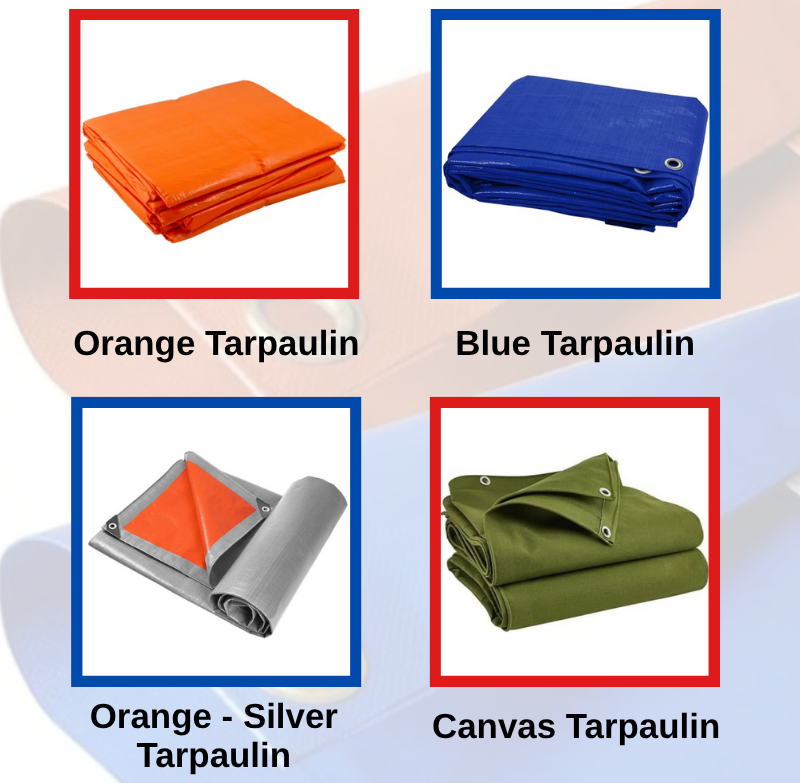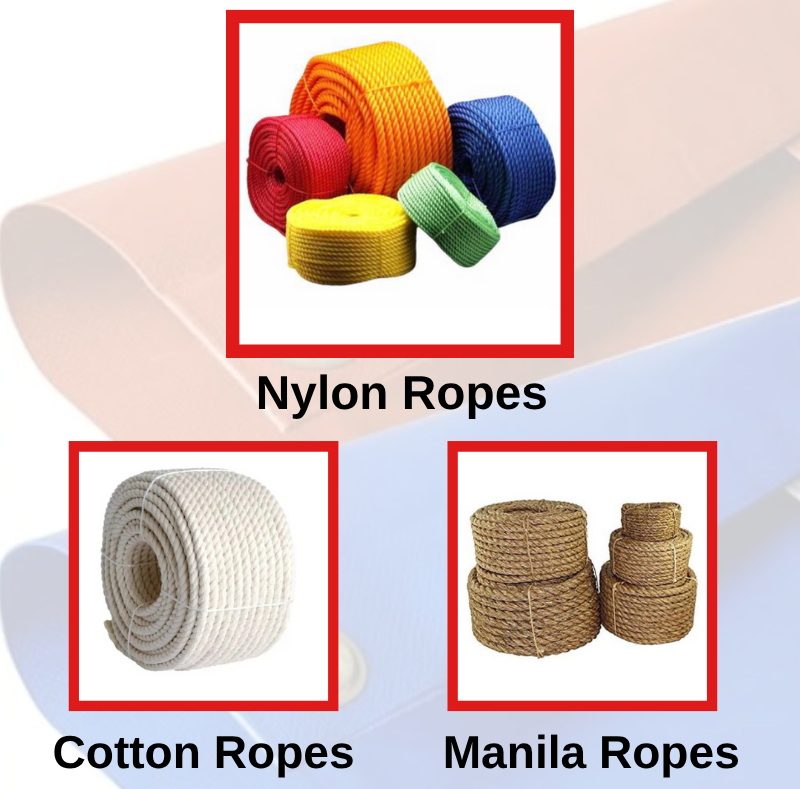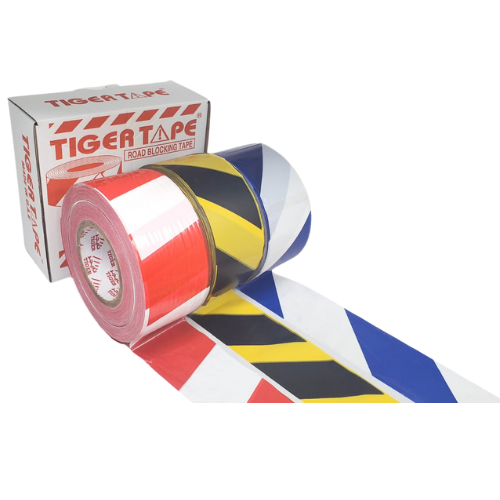Tarpaulins or tarps are versatile tools that protect people and items from weather elements like rain, wind and sun. Tarpaulins are made from materials like polyethylene, canvas, or vinyl. Tarps come in various types and colors, each suited for specific tasks. Whether you need to cover equipment, create a shelter or protect a construction site, there’s a tarp for every job. This article explores different tarpaulin types, including Orange Tarpaulin, Orange Silver Tarpaulin, Canvas Tarpaulin, Blue Tarpaulin, Fire Retardant Tarpaulin and Heavy Duty Tarpaulin, along with their common uses.
What is a Tarpaulin?
A tarpaulin is a large, flexible sheet made from strong materials like canvas, polyester, or polyethylene. Manufacturers add coatings like polyurethane or vinyl to make tarps water-resistant or waterproof. They often include grommets, metal or plastic eyelets along the edges and corners for tying down with ropes. Tarps are durable, affordable, and easy to set up, making them popular for both home and industrial use. Their sizes vary, but most are slightly smaller than advertised due to manufacturing standards. For example, a 20x20-foot tarp might measure closer to 19x19 feet.
Types of Tarpaulins
Each tarpaulin type serves unique purposes based on its material, thickness, and special features like UV protection or fire resistance. Below, we break down the most common types and their benefits.
Blue Tarpaulin
Blue Tarpaulin is a lightweight and affordable option often made from woven polyethylene. It typically has a weave count of 8x8 per square inch and a thickness of 0.005–0.006 inches. These tarps resist water for short periods but may leak under heavy rain or prolonged exposure. They’re ideal for quick, temporary tasks like covering outdoor furniture, protecting vehicles or shielding equipment during light rain. Their bright blue color makes them easy to spot, which is great for general-purpose use at home or on small projects.
Orange Tarpaulin
Orange Tarpaulin stands out due to its high-visibility color, making it perfect for safety-related uses. Construction sites often use these tarps to cover materials or create barriers, as the bright orange hue alerts workers to potential hazards. Made from polyethylene, Orange Tarpaulins are lightweight yet durable, with UV-resistant coatings to withstand sun exposure. They’re great for covering machinery, securing loads on trucks, or setting up temporary shelters during outdoor events. Their vibrant color also makes them popular for camping or marking areas in outdoor settings.
Orange Silver Tarpaulin
Orange Silver Tarpaulin combines the highly visibility orange side with a reflective silver side, offering versatility. The silver side deflects sunlight, reducing heat buildup, while the orange side ensures visibility. These tarps, often made from polyethylene are UV-treated and waterproof, making them suitable for long term outdoor use. Orange Silver Tarpaulins are commonly used in construction, agriculture and industrial settings to cover equipment, protect crops or create shade. The dual color design allows users to choose the side that best fits their needs, such as reflecting heat or signaling a work zone.
Canvas Tarpaulin
Canvas Tarpaulin made from heavy-duty cotton or a cotton-polyester blend, is strong and breathable. Unlike polyethylene tarps, canvas allows air circulation, preventing moisture buildup that can lead to mildew. Manufacturers often treat canvas with wax or polyurethane for water resistance, though it’s not fully waterproof. These tarps shine in construction, where durability matters or for covering items like firewood that need to stay dry but require ventilation. Canvas Tarpaulin is also eco-friendly, appealing to those who prefer natural materials. Its fire-resistant properties make it safer than polyethylene in high-heat environments.
Fire Retardant Tarpaulin
Fire Retardant Tarpaulin also known as FRT Tarpaulin often made from vinyl or treated canvas, resists flames and sparks, making it essential for high-risk environments. These tarps meet strict safety standards and are used in welding, industrial settings or construction sites where fire hazards exist. They’re also waterproof and resistant to oil, grease, and mildew, ensuring durability. For example, welders use Fire Retardant Tarpaulins to block sparks and protect nearby surfaces. They’re a smart choice for events or warehouses where fire safety is a priority.
Heavy Duty Tarpaulin
Heavy Duty Tarpaulin, typically made from vinyl or high-density polyethylene is built for tough conditions. With a higher weave count (14x14 per square inch) and thicker material (0.011–0.012 inches), these tarps resist tearing, abrasion and harsh weather. They’re fully waterproof and often UV-treated, making them ideal for long-term use in construction, agriculture or transportation. Heavy Duty Tarpaulins protect large equipment, cover truck loads or serve as temporary roofs during repairs. Silver Heavy Duty Tarpaulins are especially popular for their reflective properties, which help keep covered items cool.
Common Uses of Tarpaulins
Tarps are incredibly versatile, with applications across industries and everyday life. Here are some popular uses,
Construction Sites: Heavy Duty Tarpaulins and Fire Retardant Tarpaulins protect materials, tools and unfinished structures from rain, wind and sun. Canvas Tarpaulin is great for covering items that need breathability, like wood or hay.
Camping and Outdoor Activities: Blue Tarpaulin or Orange Tarpaulin works as groundsheets, tent covers or rain shelters. Their lightweight nature makes them easy to carry, while their bright colors help with visibility in the wilderness.
Agriculture: Farmers use Heavy Duty Tarpaulins to cover crops, hay or equipment. Orange Silver Tarpaulin provides shade and UV protection for sensitive plants or livestock.
Transportation: Truck drivers rely on Heavy Duty Tarpaulins or vinyl tarps to secure loads like lumber, gravel or machinery, keeping them dry and safe during transit.
Emergency Shelters: After disasters like floods or earthquakes, Heavy Duty Tarpaulins create temporary shelters. Their durability and waterproofing provide quick relief.
Home Use: Blue Tarpaulin or Canvas Tarpaulin covers outdoor furniture, firewood or vehicles during winter. They’re also handy for painting projects to protect floors and furniture.
Events and Recreation: Orange Tarpaulin or Orange Silver Tarpaulin creates shade or shelter for outdoor events, markets or festivals. Fire Retardant Tarpaulins ensure safety in crowded settings.
How Choosing the Right Tarpaulin
Picking the right tarp depends on your needs. Consider these factors,
Purpose: Need waterproofing? Go for vinyl or Heavy Duty Tarpaulin. Need breathability? Choose Canvas Tarpaulin. For fire safety, pick Fire Retardant Tarpaulin.
Environment: For sunny areas, select UV-treated tarps like Orange Tarpaulin or Orange Silver Tarpaulin. In wet climates, prioritize waterproof options like vinyl.
Durability: Heavy Duty Tarpaulins last longer in harsh conditions. Blue Tarpaulin is budget-friendly for short-term use
Size and Thickness: Ensure the tarp covers your items fully. Check the weave count and thickness for strength, higher numbers mean more durability.
Color: Bright colors like orange tarpaulns improve visibility, while silver reflects heat. Choose based on function and aesthetics.
Frequently Asked Questions (FAQs) for Tarpaulins
Can Canvas Tarpaulin be used in heavy rain?
Canvas Tarpaulin is water-resistant but not fully waterproof. It’s great for covering items that need ventilation, like firewood, but may leak during heavy rain. For waterproofing, choose Heavy Duty Tarpaulin or vinyl tarps.
Why use Fire Retardant Tarpaulin?
Fire Retardant Tarpaulin resists flames and sparks, making it essential for welding, construction, or events where fire risks are high. It ensures safety by preventing fire spread and protecting nearby surfaces.




